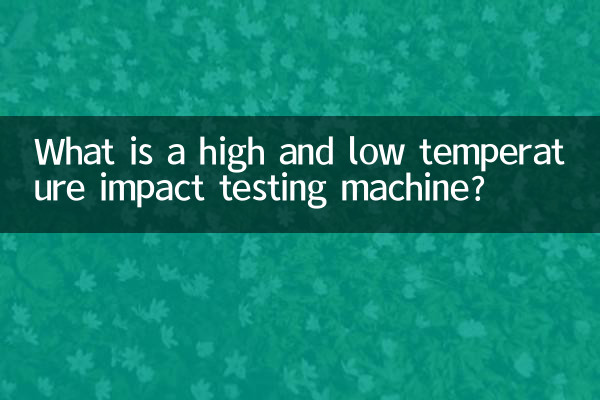What is a high and low temperature impact testing machine?
In today's era of rapid technological development, product reliability and durability have become the focus of enterprises and consumers. As an important environmental testing equipment, high and low temperature impact testing machines are widely used in electronics, automobiles, aerospace and other fields to simulate the impact of extreme temperature changes on product performance. This article will introduce in detail the definition, working principle, application scenarios and popular models of high and low temperature impact testing machines in the market.
1. Definition of high and low temperature impact testing machine

The high and low temperature impact testing machine is a testing equipment used to simulate the performance changes of products in extreme high and low temperature environments. It tests the product's ability to withstand drastic changes in temperature by quickly switching between high and low temperature environments to evaluate its reliability and durability.
2. Working principle
High and low temperature impact testing machines usually consist of high temperature chamber, low temperature chamber and test chamber. During testing, the product is quickly switched between high and low temperature chambers to simulate extreme temperature changes. Here is its basic workflow:
| steps | Description |
|---|---|
| 1 | Put the product into the high temperature box, set the high temperature condition (such as 85°C) and maintain it for a certain period of time. |
| 2 | Quickly transfer the product to the low temperature box, set the low temperature condition (such as -40°C) and maintain it for a certain period of time. |
| 3 | Repeat the above steps several times to observe changes in product performance. |
3. Application scenarios
High and low temperature impact testing machines are widely used in the following fields:
| Industry | Application examples |
|---|---|
| electronic | Test the performance of mobile phones, chips, and circuit boards under extreme temperatures. |
| car | Evaluate the reliability of automotive components (e.g., batteries, sensors) in cold and hot environments. |
| Aerospace | Simulate the performance of aircraft components in low-temperature environments at high altitude and high-temperature conditions on the ground. |
| Military industry | Test the durability of weapons and equipment in extreme weather conditions. |
4. Popular models in the market
The following are the high and low temperature impact testing machine models that have been highly searched on the Internet in the past 10 days:
| Model | Brand | temperature range | Features |
|---|---|---|---|
| TSE-11 | ESPEC | -70°C to +180°C | Rapid temperature change, suitable for testing electronic components. |
| TS-780 | Thermotron | -65°C to +150°C | High-precision control, suitable for automotive parts testing. |
| GDT-1000 | Weiss | -80°C to +200°C | Large capacity, suitable for aerospace field. |
5. Advantages of high and low temperature impact testing machines
The use of high and low temperature impact testing machines has the following significant advantages:
-Quickly detect defects: Quickly discover potential product defects by simulating extreme temperature changes.
-Improve product reliability: Ensure that the product can still work normally in harsh environments.
-cost savings: Reduce after-sales repair and recall costs caused by product failure.
6. Future development trends
With the rise of the Internet of Things and smart manufacturing, high and low temperature impact testing machines are developing in the direction of intelligence and automation. In the future, equipment will be more integrated and support remote monitoring and big data analysis to further improve testing efficiency and accuracy.
In short, the high and low temperature impact testing machine is an important tool to ensure product quality, and its application fields and technical level will continue to expand and improve.

check the details

check the details